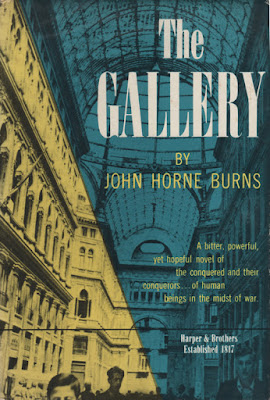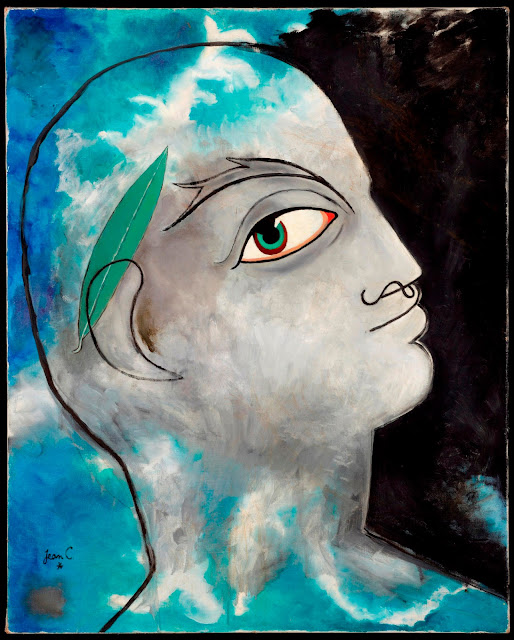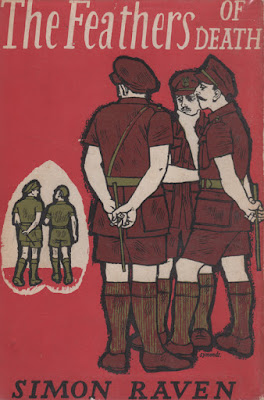 |
| New York : William Goodwin, 1933 |
Of the gay novels of the 1930s,
Goldie is the most elusive. Held by less than a handful of libraries (in special collections departments), one assumes that there are no more than an equal number being held by independent collectors. Some kind soul posted the image I include here on
LibraryThing.
Synopses of this rare novel appear in three publications. Roger Austen's is the first and most complete in his
Playing the Game: The Homosexual Novel in America (1977). James Levin's
The Gay Novel in America (1991) and John Laughery's
The Other Side of Silence: Men's Lives and Gay Identities: A Twentieth-Century History (1998) both rely on Austen (as I will).
A young man from the midwest, Paul Kameron, is an ace pilot with the Royal Flying Corps during World War I. Bailing out over Germany, he is 'brought out' while being held in a POW camp. After the war, he returns to New York with his lover, a furrier he met in Europe. Paul grows more comfortable with having entered 'Limbo' (his term for 'the gay life') when he discovers there are "more than four million others in the United States who dwelt in that twilight realm of sex."
Paul transforms into Goldie when he begins dying his hair. After his lover catches him with the shop janitor, he breaks it off and Goldie is left to hustle on Broadway. He later has an affair with a gangster and starts working in a gay restaurant in the Village.
Goldie's friend, Jack Shaw, has the idea to form a gay liberation club. Its first meeting takes place in the restaurant and draws six people, including Goldie. In drafting their resolution, they aim to abolish the laws in the State of New York that make 'inversion' a crime. They cite both France and Italy having both eliminated similar laws over 100 years ago. Thus, The Twilight League was born. And just as quickly it met its demise due to its members each having plans to exploit the League in different ways, up to and including running a connections service where "wolves could obtain fairies."
Laughery, in
The Other Side of Silence, ends his synopsis of
Goldie by asking the question "... in 1933 who knew any homosexuals who thought they had civil rights to agitate for?" George Chauncey's
Gay New York: Gender, Urban Culture, and the Making of the Gay Male World 1890-1940 (1994) offers a place to start answering this question.
 |
FROM TOP TO BOTTOM: Magnus
Hirschfeld, Henry Gerber
|
It is accepted that the mass mobilization of American men during WWII and their exposure to more progressive attitudes about sexuality in Europe led gay men after the war to see new possibilities for their own lives, especially as they settled in New York and San Fransisco. The evidence also suggests that service members during WWI, albeit fewer of them, were also exposed to a cultural and political climate for homosexuals in both Paris and Berlin which far surpassed what they could have imagined in small-town America or even New York.
Magnus Hirschfeld founded
The Wissenschaftlich-humanitäres Komitee (Scientific-Humanitarian Committee) in May 1897 to campaign for legal recognition of gay lesbian and transgender men and women and against their persecution (specifically Paragraph 175). It was the earliest gay rights group, but certainly not the only one in early 20th century Berlin. It continued its activities through 1933, when the Nazis destroyed
The Institut for Sexualwissenschaft (Institute for Sexual Sciences) which housed it's offices.
From 1920 to 1923, Henry Gerber had served with the Army of Occupation in Germany after WWI and had seen firsthand the openness of Berlin during this time and was upset about the way homosexuals were treated in the United States. In December 1924, now living in Chicago, Gerber founded
The Society for Human Rights by filing a charter with the State of Illinois. Gerber chose to use the same name as was used by the german group he most closely identified with, Bund für Menschenrecht (The Society for Human Rights).
A police raid and subsequent arrests brought The Society for Human Rights abruptly to an end in the summer of 1925. Gerber's Society had concentrated its efforts on the State of Illinois where they focused on reforming laws that criminalized homosexual acts. This sounds suspiciously similar to the goals of The Twilight League in the State of New York in Kenilworth Bruce's
Goldie. After three costly trials for deviancy (all eventually dismissed), and the loss of his job with the post office, Gerber relocated to New York. One wonders if Kennilworth Bruce didn't borrow from Gerber's life when writing
Goldie.
For more about
Goldie and hustler culture, see George Chauncey's
Gay New York: Gender, Urban Culture, and the Making of the Gay Male World 1890-1940 (1994) and Mack Friedman's
Strapped for Cash: A History of America's Hustler Culture (2003). For an excellent history of the gay rights movement in Berlin see, Robert Beachy's
Gay Berlin: Birthplace of a Modern Identity (2014). For more about Henry Gerber and The Society for Human Rights, see Jonathan Ned Katz'
Gay American History: Lesbians & Gay Men in the U.S.A., Revised Edition (1992).
Bibliographies & Ratings: Mattachine Review (P); Young (490,*) Note that the Mattachine Review rating of P is not defined in the legend but may be a typo for O, which means it was not examined but is believed to have pertinent content. Garde specifically excludes works that could not be examined.












![Signet #1064, The Descent by Fritz Peters [1953] by James Avati Signet #1064, The Descent by Fritz Peters [1953] by James Avati](https://blogger.googleusercontent.com/img/b/R29vZ2xl/AVvXsEiQ7P7mdO7k34H7QL9Qw_CVyqNdeZIAiNCHPxhMDhDx4QiDso4HeeMU7gEiIp1_zK9Q1YJ0uyBFmSqGEo9J10w3pFnxRdSX-cR28Ml5zhM42IXDBKFQBDZYOcVU7zWW6sVgoBz4jdcJxfI/s400/AvatiFP.jpg)


![Fritz Peters uses a wire recorder to make notes November 27, 1950 [cat 3119-0008] Fritz Peters uses a wire recorder to make notes November 27, 1950 [cat 3119-0008]](https://blogger.googleusercontent.com/img/b/R29vZ2xl/AVvXsEjE5gwv0Nw9-wJ9TrK5n0IRIYVY9WcjfqJPFW_sqdQV9bYVy0qAEXehSqd1azHdHWamU8r1Agcw3suZ_MW2diZ_jgIprxTOZ-JhQDoZKYDFKtIOkf2Zyht4aX29D82CdxQrUFhqW7REWQ4/s400/tranquille1.jpg)
![Fritz Peters in the kitchen November 27, 1950 [cat 3119-0009] Fritz Peters in the kitchen November 27, 1950 [cat 3119-0009]](https://blogger.googleusercontent.com/img/b/R29vZ2xl/AVvXsEgog_qnBAjnWN8Jk2a3XJeNJLxT6UyzrR4cpfzElEraNvTABjbk1gWlxc1agsGJ8hnJzC8rEoUd54V_xjMKh1gV_F6e75XjlqJXxi5eL5YsNcZzAg0YCbgAnVIay18nx2fdfzkJq9YM8X4/s400/tranquille2.jpg)
![Fritz Peters with American, English and paperback editions of his first novel, The World Next Door November 27, 1950 [cat 3119-0010] Fritz Peters with American, English and paperback editions of his first novel, The World Next Door November 27, 1950 [cat 3119-0010]](https://blogger.googleusercontent.com/img/b/R29vZ2xl/AVvXsEhiQA0jKgMsVKyRceAWp6ZzytlCz6uvfTta98vPhltt2PkATSfnJS3x3AxdNBDHY1tR471GNk27Ce-TSnyHtsPjL27B6AZX2A9b8BtHreVTnLkChlSWXh3z2O6AMY1I_eNW70kok2vETm4/s400/tranquille3.jpg)
![Fritz Peters leaving cabin 5 to begin research November 27, 1950 [cat 3119-0004] Fritz Peters leaving cabin 5 to begin research November 27, 1950 [cat 3119-0004]](https://blogger.googleusercontent.com/img/b/R29vZ2xl/AVvXsEis9haTBwPraDP0QB2OiCTHsCZXw05CFm1mLCG79fLOZDbkxa708lZTn9CW1CuNxEuwZXR0myLQVErXujVEwgMIHWkntZrJzH1SzqXGPwjALw5IV3P28fEF8CquDx56F65aLaJSSYz5QBg/s400/tranquille4.jpg)
![Fritz Peters leaving cabin 5 to begin research (detail) November 27, 1950 [cat 3119-0004a] Fritz Peters leaving cabin 5 to begin research (detail) November 27, 1950 [cat 3119-0004a]](https://blogger.googleusercontent.com/img/b/R29vZ2xl/AVvXsEhMR5Quhhk1vqvIJO5LVP-RGbsAfqTWUvGdIqQW2jkUZTTKPftXLIdgvTPusEb1WoUFL1WjW9zuPogSn89mBh2RSxMHghMUqp9gJPwWOKNB-qGUA6AUOxrHYdAaYDWLlHqIsGNTriMF5JI/s320/tranquille4A.jpg)
![Fritz Peters along Route 20, NY November 27, 1950 [cat 3119-0003] Fritz Peters along Route 20, NY November 27, 1950 [cat 3119-0003]](https://blogger.googleusercontent.com/img/b/R29vZ2xl/AVvXsEhvSPXT30NJeixsDrBDx2UrSsozE-azMFP_-NCjniWqhh_JlI1V0NHgchWntgkXcuTfv1NnneHHVGQJaRbnyQ_XYTAS7qGaWkzBo5kbsdftxdNjdPEib0azg13-l16VZCu8vDcgozMVmUI/s400/tranquille5.jpg)
![Fritz Peters along Route 20, NY (detail) November 27, 1950 [cat 3119-0003a] Fritz Peters along Route 20, NY (detail) November 27, 1950 [cat 3119-0003a]](https://blogger.googleusercontent.com/img/b/R29vZ2xl/AVvXsEg4FtulfqiAhmtehM8DSVXGc1aHiPOAWrzqkzg1aWm-NVCbPFVKOJzW2CRvtjjCG2dOeZCrW4yG0j6SwYUuVJQ0Xf4OzLtRFcoJNb9NXcGFiQkzhB-bnGP19XysmcebjQHLjOGK_FlYm5I/s320/tranquille5A.jpg)
![Fritz Peters along Route 20, NY November 27, 1950 [cat 3119-0001] Fritz Peters along Route 20, NY November 27, 1950 [cat 3119-0001]](https://blogger.googleusercontent.com/img/b/R29vZ2xl/AVvXsEhNJm-DDh1a4b6VXbnnxNghtdxLaM7b2CC6lr2iCFx_5vrj6Rke6A4yRbcqAy-Buu_7sBoFotstjOzfVUA-hhRx3abpKEkeqH0IxKH0akJGvgiHRVhVMcwW61rHZvkDD0LM4dUOYCSnr3I/s400/tranquille6.jpg)
![Fritz Peters along Route 20, NY (detail) November 27, 1950 [cat 3119-0001a] Fritz Peters along Route 20, NY (detail) November 27, 1950 [cat 3119-0001a]](https://blogger.googleusercontent.com/img/b/R29vZ2xl/AVvXsEjj8F21Lvv8U0f4sSLyOz5rxcPtjpKhopRf2ySpv1cOPbv-SP4YsTiDHDb3hhLlD_dh7r3kvp10zm4AjjSJmWhKQRiIbkCb6QFGL9oy2lKsasgKEvJLA_CEJyfEXOej6gz8xsogFSz_tbo/s320/tranquille6A.jpg)
![Fritz Peters along Route 20, NY November 27, 1950 [cat 3119-0002] Fritz Peters along Route 20, NY November 27, 1950 [cat 3119-0002]](https://blogger.googleusercontent.com/img/b/R29vZ2xl/AVvXsEgr5MtbJXl9pw4ZVJXUZeMXO07cy8QeQmB8ReNx-t-ns3fASUaWWRk3rHIlhZmlQY77nMP5wofTBX0qgN4HU3lN5W_pR1oAMIJ7UKAizNlthXQFgwLv38K-D-PqvfEtK5m0gIcV_unW4qU/s400/tranquille7.jpg)
![Fritz Peters along Route 20, NY (detail) November 27, 1950 [cat 3119-0002a] Fritz Peters along Route 20, NY (detail) November 27, 1950 [cat 3119-0002a]](https://blogger.googleusercontent.com/img/b/R29vZ2xl/AVvXsEg4cD7S_BySWs30w_uPJeeKSTtt_h2QR5UJY7Hv9D4aC3o9H2sq1X99J4qTKHBeTbanIvuS4uCEPIvKFKBOEQ7YqUtsHTq6Z8mJcSxT_fJCoadvfDQbrBs5quLcYqURwuTwQG70QpLhpeg/s320/tranquille7A.jpg)
![Fritz Peters interviews Mrs. James Erskine, proprietor of the Madison Motor Court, NY November 27, 1950 [cat 3119-0005] Fritz Peters interviews Mrs. James Erskine, proprietor of the Madison Motor Court, NY November 27, 1950 [cat 3119-0005]](https://blogger.googleusercontent.com/img/b/R29vZ2xl/AVvXsEgVlFSbJ4lmlp6-bMqtxT65zP2XqaKtl-rdscsKx4QTCWyAj1Vh3pQfmUIWlsXSB86yDnC9hESV2xfHx1XFrg6Snu_VTTRhdVnAwfRz-hGBAETJeBWjddqArvPjx6Atag-65LKMhj7ae9Q/s400/tranquille8.jpg)
![Fritz Peters interviews Mrs. James Erskine, proprietor of the Madison Motor Court, NY (detail) November 27, 1950 [cat 3119-0005a] Fritz Peters interviews Mrs. James Erskine, proprietor of the Madison Motor Court, NY (detail) November 27, 1950 [cat 3119-0005a]](https://blogger.googleusercontent.com/img/b/R29vZ2xl/AVvXsEiQObv0yhtux8Ot8wK41TrHy_RdaPLEvUcEZleZK1yBRwMuA5veL8CQU1tmHs0MYDFCSKPENF8WyexccLEtJshsADFXVueho22JfYRJ_wvYEPslcym4rOPNf75J9P0xHTRrX5w6j051x3k/s320/tranquille8A.jpg)
![Fritz Peters correcting galley proofs of his second novel, Finistère November 27, 1950 [cat 3119-0007] Fritz Peters correcting galley proofs of his second novel, Finistère November 27, 1950 [cat 3119-0007]](https://blogger.googleusercontent.com/img/b/R29vZ2xl/AVvXsEjykjpvEH3AFZYhBj5XSefkd1HKTRIiZIy0cYuJIlmUG4rhCcIxG4vmincRlNqNSrHaYe5ceQY6Uw3hT_qh-YJWUVB8q4VOYxAzqyIWErTVw3rTAFFuoOl_PFuJYP2sV6WD5_QzvGhftAU/s400/tranquille9.jpg)
![Fritz Peters at the piano November 27, 1950 [cat 3119-0006] Fritz Peters at the piano November 27, 1950 [cat 3119-0006]](https://blogger.googleusercontent.com/img/b/R29vZ2xl/AVvXsEjGPwyD6XEquIDJmVV6Nhno7o-JBDOyNAJ_H6kCmvn7-U4UOrjwFJYH_b_HMYHdV98NNg8iX855UMUu789YDs_v2ChYzXoeMlW5f-V2gXe3CqllJAc_c96EL8HsEfzyKwo88zKs70wcyVE/s400/tranquille10.jpg)
![Fritz Peters and Richard Hauer Costa discuss The World Next Door December 5, 1950 [cat 3899-0001] Fritz Peters and Richard Hauer Costa discuss The World Next Door December 5, 1950 [cat 3899-0001]](https://blogger.googleusercontent.com/img/b/R29vZ2xl/AVvXsEjhvWHmXupmcmY3AtL2SYNRKmcnjDGlNesKBWNh-8jCA5loCwiNP0Rq-QQ9yZ7ZU-2NM0SChomLYY6U0HMiytEWyProVDpQTmRCvbgh71kbwgRbx4WTixSX5cPEjieuXGvE9acRavzKF-E/s400/tranquille11.jpg)
![Fritz Peters reads Richard Hauer Costa's reporter notebook December 5, 1950 [cat 3899-0002] Fritz Peters reads Richard Hauer Costa's reporter notebook December 5, 1950 [cat 3899-0002]](https://blogger.googleusercontent.com/img/b/R29vZ2xl/AVvXsEjWs7kgvMuP7PW6HAWNjqXbYSd4RC0i6-51WE1jyfV5hwgtoJKjF8ZB4pTNuw_KJO6ny9fxMvYOk3pGafAqLoM-oG2r8iKHlSYvY_Lbik8kOOJmgXluK92UiH-7Ff-Z8OsWJl5aw4x0-2I/s400/tranquille12.jpg)






